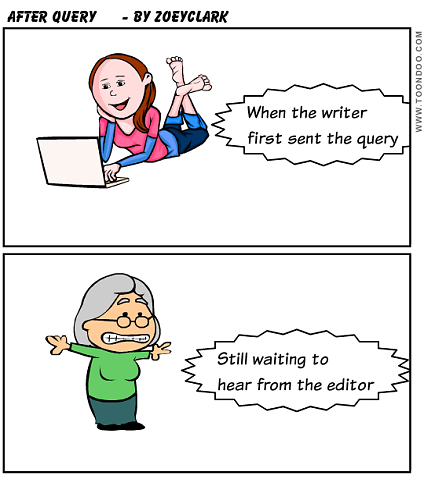
We all know it’s essential to craft an intriguing, easily readable query letter. That’s how we (hopefully) get the editor’s attention. And if you need to polish your query skills, I suggest reading 7 Great Query Letter Resources: A List of (E-)Books, Articles and Blog Links.
This post is about what happens after having sent that great query letter.
1) Keep track of your query. I prefer a simple excel sheet. I note when I sent it, when I should follow up (should I not hear from the editor before), what other publications the idea might fit if the query is rejected or doesn’t get a response after the follow-up. I also include a section for brainstorming for other ideas for the same publication. After all, I want to write for this magazine more than once.
2) Keep researching other markets and their guidelines, and make sure you take notes about the guidelines, payment terms, topics and articles already published on the publication. After all, your querying days are never really over.
3) Write for, market & optimize your blogs. If you’ve a writer’s blog, work on it. If you don’t have a writer’s blog already, it’s time to start one. You don’t need to write about writing related topics, but you need to post article samples and links to your published work. The blog will serve as a portfolio, so take full advantage.
Plus, the more you know about blogging, the easier and more fun it will be for you to get blogging jobs, and/or monetize your own blogs.
If you have several blogs, work on them too. They all serve as your portfolios as well, proving your writing skills in those niches.
4) Keep networking with other writers (and bloggers).
5) Assuming you heard from the editor before needing to follow up, go ahead and start working on the article – keeping the editor’s notes in mind. Sometimes writing a killer article that will satisfy your editor might be harder than writing the query.
If the editor liked the idea but requests a few tweaks, or another query based on these tweaks,
Do so.
If the editor tells you they liked your style but can’t use that piece, keep querying .
6) Assuming you didn’t hear from the editors, follow-up on your old queries at the suggested time period. Many publications offer their response time and when you should follow up if you don’t hear from them in that period. If no specific time is given, follow your gut. If it is a massive magazine, you might want to wait for a couple of months. If it is a website, 2-3 weeks before following up should be fine.
7) Read about the topics you are writing on. This is great for self-improvement, discovering markets you weren’t aware of, getting to know the markets you know better, finding authors to network and giving you new article ideas.
8) Query other publications, and keep track.
9) When You Get An Answer or No Answer After the Follow-Up:
- If you haven’t heard up from your follow-ups after a couple of weeks, feel free to pitch the idea to other publications. But to be on the safe side, notify the first editor nicely. This is to be on the safe side, and not to burn any potential bridges.
Of course, keep tracking queries and their responses.
- If you got a no with some suggestions from the editor, keep them in mind. But there’s nothing much you can do after a “no, thanks”. You cross your fingers for the next publication.
10) Use this list in order and/or mix things up. Add your own points and apply them at a pace that suits you best.
Best of Luck.
Related Posts:
9 Awesome (Free & Paid) Places to Find Market Guidelines
7 Great Query Letter Resources: A List of (E-)Books, Articles and Blog Links
6 Reasons Why Every Writer Should Blog